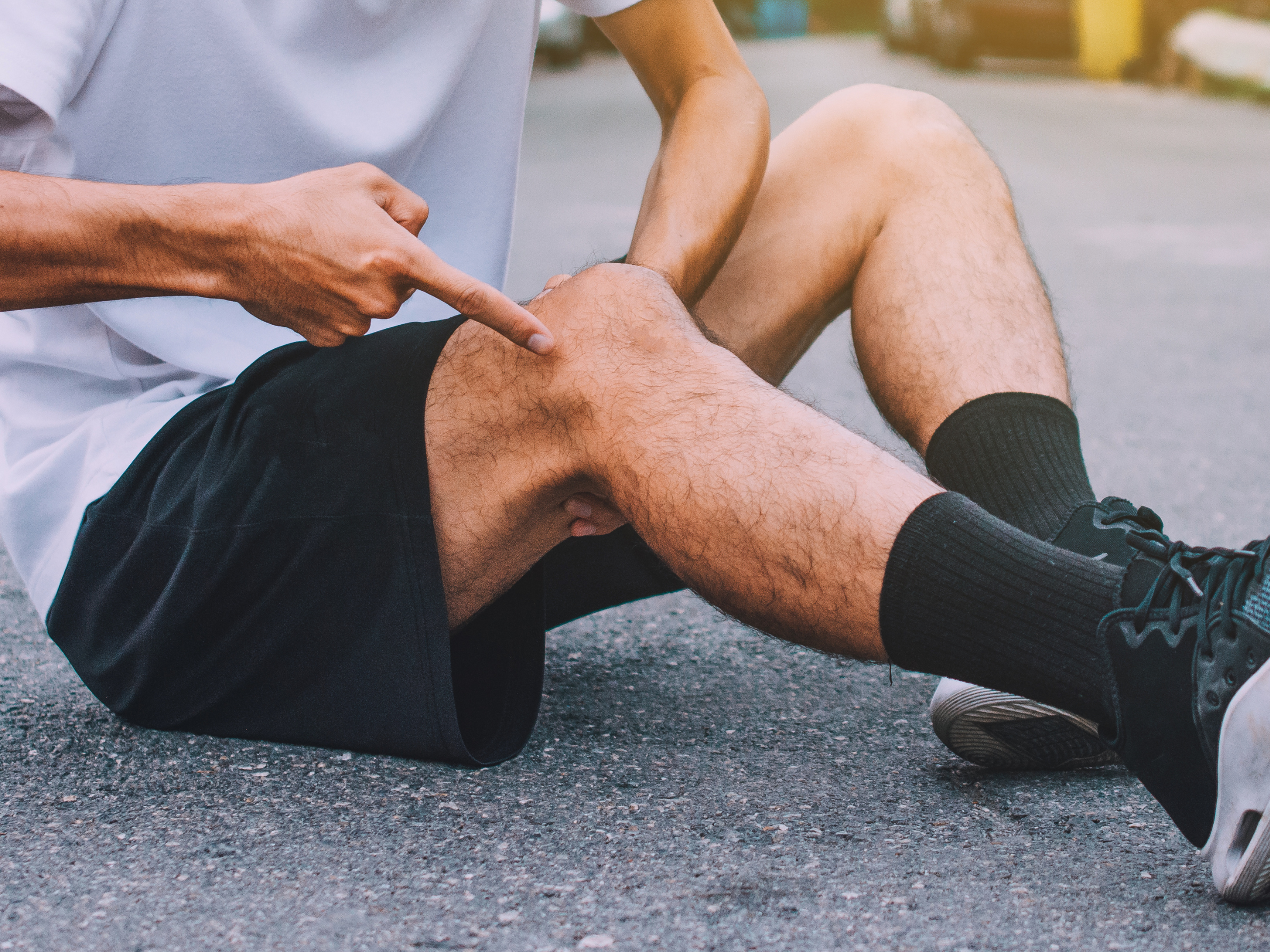IT band syndrome: The runner's recovery roadmap
IT band syndrome is the most common cause of lateral (outer) knee pain in runners.
Often, it starts as a mild annoyance that makes your runs unpleasant. But continue running through the discomfort, and you'll likely feel things worsen.
What makes IT band treatment tricky is that it can have many causes. The key to a quick and successful recovery lies in:
- identifying what caused your case
- and tailoring your treatment towards that.
So, let's start by looking at what the IT band does and why it gets injured.
What is the IT band?
The IT band is a thick strip of connective tissue that runs along the length of your outer thigh.
It starts at the top of your pelvis (ilium), runs over your hip joint, and attaches to the outer edge of your shin bone (tibia), just below your knee joint.
Current evidence demonstrates that your IT band:
- Anchors to your thigh bone
- Attaches to your hip and knee joint capsules
- Has a fat pad beneath it that contains little nerves and blood vessels
In addition, your Tensor Fascia Latae (TFL), Glute Max, and outer thigh muscles attach to it.
What does your IT band do?
Your IT band helps to keep your pelvis, hip, and knee level and in line when you’re standing or moving. Because it’s connected to your TFL and Glute Max muscles (hip muscles), it also helps to move your leg and absorb shock when you run.
What it can’t do
Although your IT band has some elastic properties, it’s not as flexible as your muscles, so it can’t stretch as they do.
What is IT band syndrome?
IT band syndrome is an overuse injury that causes pain in the area of your IT band around the outer side of your knee.
It's a common condition in athletes, especially distance runners. But it can happen to anyone who performs activities involving repetitive hip and knee movement, such as cycling, jumping rope, and even doing long walks.
Symptoms of IT band syndrome
How will you know if you have IT band pain?
You may have IT band syndrome if your pain:
- Developed gradually during exercise
- Is located over the outer side of your knee
- Only comes on during movement, not rest
- Happens during repetitive knee bending and straightening activities
- Is most pronounced in the first 30 degrees of knee bending (from fully straight)
- Can be reproduced by pressing on the painful area
In severe cases, you may also feel it with everyday activities such as walking down stairs or squatting down.
Other activities that can aggravate your IT band pain include:
- Longer runs
- Downhill running
- Running on a camber (slanted surface)
- Cycling
- Intense stretches that compress your IT band over the side of your knee
- Heavy pressure on the painful area (e.g., foam rolling, deep tissue massage)
What's the source of IT band pain? (what’s being injured)
Experts currently believe that IT band syndrome is caused by the IT band pressing excessively against the bones on the outer side of your knee.
But there’s still a debate about what structure becomes injured and causes the pain you feel. A few theories exist:
1 - Injury to the IT band itself
Excessive compression of the IT band over the bone as you bend and straighten your knee may injure your IT band fibers.
What the science says: Most cases of IT band syndrome show little evidence of injury to the actual IT band fibers.
2 - Inflammation of the IT bursa
A taut IT band may compress and irritate your IT bursa (the fluid-filled sac between your IT band and thigh bone) when you bend and straighten your knee.
What the science says: IT bursas are not present in all people, and you can have IT band syndrome with or without an IT bursa.
3 - Compression of the IT fat pad
When your IT band is pulled taut, it draws closer to your thigh bone, leaving less space for the structures beneath it. As a result, it compresses the IT fat pad, which irritates its nerves and blood vessels - leading to inflammation, pain, and swelling in the area.
What the science says: Currently, experts tend to lean toward a "fat pad compression" theory, but no research has ruled any other theory out.
Does the source of IT band syndrome pain matter?
Causes of IT band syndrome
What causes IT band syndrome?
Individual factors
Training factors
Fatigue and IT band syndrome
Fatigue impacts your body's natural repair processes but can also amplify poor movement patterns in your hip, which may contribute to IT band syndrome.
Fatigue can be in the form of:
- Single session fatigue - hard sessions without proper preparation
- Consecutive session fatigue - training on tired legs; not leaving enough rest between sessions
- General fatigue - lack of sleep or adequate nutrition, increased stress, physical or mental exhaustion
Treatment for iliotibial band syndrome
Most IT band syndrome cases can be effectively treated with conservative treatment. Surgery is rarely necessary for IT band syndrome.
Evidence suggests that IT band syndrome responds best to a three-phase treatment approach, which includes:
Phase 1: Initial pain management
Aim
This phase helps calm the injured area and begins the healing process.
What to do
- Avoid aggravating activities - stop running or significantly reduce your running volume
- Take anti-inflammatory medications (NSAIDs) - if necessary, and only those prescribed by a doctor
- Ice or cool the injured area - ensuring you follow safe instructions
- Massage or foam roll - only over the muscles attached to your IT band
- Wear supportive insoles - if necessary and if they work for you (if you're uncertain, a podiatrist can assess this)
- Use an IT band syndrome knee brace or strap - if you feel it helps for your pain, but there's no current evidence supporting their use
- KT tape can also help relieve pain - you can find a kt taping technique for iliotibial band syndrome here
What to avoid
- Corticosteroid injections - can reduce your pain in the short term but may have adverse effects on your recovery in the long-term
- Strong massage or pressure over the injured area - foam rolling or deep tissue massage over your painful IT band area can worsen your injury
The Exakt app guides you through this process step by step. The app, designed with expert physical therapists, offers personalized exercises and robust monitoring tools that help you determine your knee's load tolerance and track your recovery progress.
Phase 2: Strength and control exercises
Aim
This phase helps restore your strength and mobility as your injury gradually recovers. It can help correct the underlying causes of your injury, get you back to running pain-free, and prevent future injuries.
What to do
- Graded strengthening and movement control exercises - help improve your hip, knee, and ankle muscles' load-bearing capacity and your ability to control them
- Stretching exercises of the muscles attached to your IT band - help reduce tension in the muscles and their pull on your IT band
You can find more detailed information about what exercises are best for IT band recovery and how to introduce them into your rehab plan here.
What to avoid
- Starting at the wrong strength and control level for you
- Progressing the intensity of your exercises too soon
- Vigorous stretching that aggravates your pain
Phase 3: Return to running training
Aim
This phase helps optimize your movement and training technique to reduce the strain on your IT band. It also prepares your body for your specific running demands so you can return to running safely.
What to do
- Phased return to running program - gradually and safely increases your running volume and intensity
- Skill development - trains different movement patterns, such as plyometric or agility drills
- Running technique training - improves your running technique to reduce the strain on your IT band
You can read more about how to safely get back to running after injury here.
What to avoid
- Pushing through extreme levels of discomfort (some slight discomfort is OK during rehab, but it's crucial to work within limits safe for you)
- Ramping up your running distance too quickly
- Increasing your running intensity too quickly
- Not allowing enough recovery time between runs
The IT band syndrome rehab plan in the Exakt app helps you find your baseline level of discomfort and teaches you to monitor changes and adjust your training appropriately. It also includes advice on how to adapt your running technique to reduce the strain on your IT band.
What else can help treat IT band syndrome?
IT band syndrome recovery time
How long does it take to recover from IT band syndrome?
IT band syndrome recovery usually takes around 6 to 12 weeks with conservative treatment, but this timeline depends on:
- The severity of your injury
- How quickly you started with proper treatment
- Your body's natural healing ability
If your injury is severe or you’ve tried to train through the pain for a long time, recovery will likely take longer than 12 weeks.
Can you prevent IT band syndrome?
IT band syndrome is preventable. The best ways to ensure it doesn't happen are to:
- Do regular strength and mobility training
- Avoid sudden increases in your running training volume and intensity
- Vary the surfaces your train on
- Wear running shoes that give you proper support (tailored to your needs)
Conclusion
For runners, iliotibial band syndrome can be a frustrating injury to treat.
Now that you know what causes IT band syndrome and how to address it properly, you’ll be on the right track with your recovery and can start confidently setting your future running goals again.




